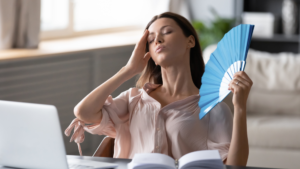 With energy prices surging across the country, few Americans can afford to run their air conditioner all day. At the same time, states are experiencing extreme temperatures more often than ever before. As a result, people have begun looking for new ways to protect themselves from hot weather. High temperatures can be dangerous, but don’t require expensive solutions. Here are a few simple ways to survive a heat wave without air conditioning.
With energy prices surging across the country, few Americans can afford to run their air conditioner all day. At the same time, states are experiencing extreme temperatures more often than ever before. As a result, people have begun looking for new ways to protect themselves from hot weather. High temperatures can be dangerous, but don’t require expensive solutions. Here are a few simple ways to survive a heat wave without air conditioning.
Avoid Activity
Physical activity raises your body temperature and depletes salt and fluids, leaving you vulnerable to heat stroke and heat exhaustion. During a heat wave, temperatures rise rapidly in the morning and stay warm well into the evening, especially in urban areas. Rest as much as possible during the hottest part of the day (10 a.m. ‒ 6 p.m.). Save chores, exercise, and yard work for the morning hours or until after the sun has gone down.
Drink Water
Hydrate throughout the day, even if you don’t feel thirsty. By the time thirst sets in, you’ve already lost a significant amount of water. Try taking a sip every fifteen minutes when you’re out in the sun. Water is the best way to replenish your fluids, but sports drinks with balanced electrolytes can also be effective.
Don’t Drink Alcohol or Caffeine
Alcohol and caffeine are diuretics, which cause you to lose water. Without sufficient fluids, your body won’t be able to regulate your internal temperature, increasing your risk of heat stroke and heat exhaustion.
Don’t Eat Large Meals
Food affects your metabolism. The more you eat, the harder your body has to work to properly digest your food, and the hotter you’ll get. Nuts and proteins take a lot of energy to digest while fruits, vegetables, yogurt, and cold soups take very little. Salty foods (e.g. potato chips, pretzels) are also a good idea because they replenish the salt you lose from sweating.
Stay Out of the Sun
Direct sunlight not only damages your skin, but also raises your body temperature and speeds up dehydration. Stay indoors as much as you can. If you go outside, stick to the shade and wear sunscreen with at least 30 SPF.
Wear Light, Loose-Fitting Clothing
Tight, thick clothing traps body heat. Dark clothing absorbs sunlight. Light, loose-fitting clothing, on the other hand, reflects sunlight and lets you shed excess body heat. Choose natural, breathable fibers such as cotton, linen, and hemp. Synthetic fibers, such as nylon, wick away moisture, which helps keep you cool.
Open Doors & Windows
Managing airflow is one of the easiest ways to control the temperature inside your home. Opening doors and windows on opposite sides of your house creates a cross breeze that removes heat. However, air doesn’t always flow through your home the way you’d expect, so experiment with different doors and windows.
Generally, though, the further the air has to travel, the more effectively it cools your home. For instance, opening windows on the top and bottom floor lets air cycle through your entire house rather than a single room.
Keep Drapes Closed
While air circulation is important, you should never open windows that get direct sunlight. Keep them closed with drapes or blinds drawn. Blocking the sun helps maintain lower temperatures inside your home.
Turn Off the Lights & Oven
Lights, ovens, dishwashers, dryers, and washing machines are heat sources. Use them sparingly during the day. It not only keeps your house cool; it saves money. During summer, energy prices are generally highest from 7 a.m. – 9 p.m., while other people are running their TVs and air conditioners.
Grab a Wet Towel
If you don’t have a pool, place a wet towel on the back of your neck or stick your feet in a bucket of ice water. Spritzing water on your face also helps.
Learn the Signs of Heat Stroke & Heat Exhaustion
Though heat stroke and heat exhaustion are both caused by excessive temperatures, they are separate conditions. Heat exhaustion occurs when you lose excessive amounts of water and salt. Symptoms include:
- Headache
- Nausea
- Dizziness
- Weakness
- Irritability
- Thirst
- Muscle cramps
- Heavy sweating
- Cold, clammy skin
- Abnormally high body temperature
People suffering from heat exhaustion also urinate less often. If someone you know is suffering from heat exhaustion:
- Move them out of the sun
- Remove excess clothing
- Give them water, preferably cold
- Soak a towel in water and apply it to their forehead
- Give them a cold shower
- Call 911 if symptoms persist for 30 minutes or more
Heat stroke, on the other hand, occurs when the body loses the ability to cool itself. The person can no longer sweat and body temperature rises rapidly, sometimes reaching 106°F in as little as ten or fifteen minutes. Signs someone is suffering from heat stroke include:
- Extremely high fever, over 104°F
- Confusion
- Irrational behavior
- Sudden anger or instability
- Nausea and vomiting
- Slurred speech
- Red Skin
- Hot, dry skin
- Profuse sweating
- Rapid heartbeat
- Fast, shallow breathing
- Seizures
If heat stroke is not treated quickly, it can cause permanent damage or even death. Call 911 immediately. While you’re waiting:
- Move the person into the shade
- Remove excess clothing
- Cover them with damp towels
- Give them water
- Fan them
- Shower them with lukewarm water (59-65°F)
- Apply ice packs to the head, neck, armpits, and groin